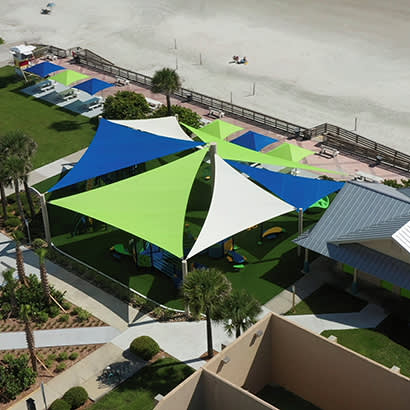
For an enhanced digital experience, read this story in the ezine.
Why do we need shade? According to the National Oceanic and Atmospheric Administration, over the past five decades, we have seen depletion of the earth’s ozone layer. When it comes to our health, this is alarming because a decrease in the amount of ozone means that an increased number of ultraviolet (UV) rays reach the earth’s surface, and prolonged exposure to these rays can cause sunburns, leading to skin cancer over time. The following are some disturbing facts published by the American Cancer Society and Skin Cancer Foundation:
- Millions of people in the United States develop skin cancer annually, and it is the most common form of cancer.
- At least 1 in 5 U.S. residents will develop skin cancer by the age of 70.
- More than two people die of skin cancer in the United States every hour.
- Having five or more sunburns doubles your risk for melanoma.
- One bad sunburn during childhood can cause skin cancer years, or even decades, later.
Because of these health risks, individuals should take measures to keep themselves safe in both the short and long term. And, the Centers for Disease Control and Prevention’s (CDC) first recommendation for protection from UV radiation: Stay in the shade.
As more and more people become aware of the harmful effects of unprotected sun exposure, park and school administrators are increasingly providing sun protection for the public. Playgrounds, splash pads, pools, skate parks, basketball courts, bleachers, dugouts and concession areas, which were once left uncovered, are being protected with attractive shade canopies in lively colors and a variety of shapes and sizes. Especially where children’s health and welfare are concerned, this once “optional” park amenity is quickly becoming required equipment.
Choosing the Right Kind of Shade
The industry has answered the call for long-lasting, durable and attractive shade products. The best products on the market come in a range of colors, use quality materials, and offer extensive warranties and features, including the means to easily remove the canopy and replace it later in the event of a severe storm or for the winter season.
When shopping for a shade product, ask the manufacturer if the shade product you are contemplating offers all the following:
- Rust-through corrosion warranty on metal components
- Deterioration warranty on fabric canopies (including the stitching thread) and cables
- Stainless steel cables and hardware for maximum corrosion resistance
- Easy and reusable removability mechanism built in, with its own long-term warranty
It’s also a good idea to look for shade products that have innovative design elements, such as the built-in design mechanism by Shade Systems, Inc., that enables park management to remove and then reattach shade canopies for the winter season or in the event of a severe storm like a hurricane. While canopies are heavy duty and structures are generally engineered to withstand at least 90 mph wind speeds, they do not provide a substantial snow load rating, nor can they survive a hurricane. It is important to be able to remove them when needed, and to easily reattach them later. This will eliminate the need to hire expensive outside installers on an annual basis.
The Bottom Line
Providing shade at public places is no longer an option when people’s health is at risk. If you choose wisely, shade can be a long-lasting investment for the public good that’s aesthetically pleasing, maintenance-free, and easy to remove and reattach by your staff.
Alan Bayman is President of Shade Systems, Inc.

